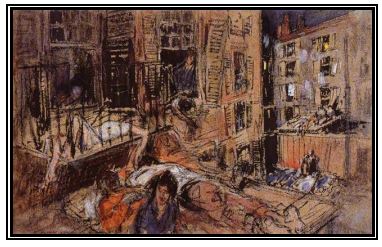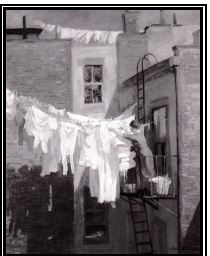The Birth of the Tenement Fire Escape
On February 2, 1860, a terrible fire broke out in a tenement at 142 Elm Street (today Lafayette Street, just north of Howard Street in SoHo). The building was occupied by 24 families, according to The New York Times account at the time, and the fire started in a bakery in the basement. Ten women and children lost their lives largely because firefighters’ ladders did not reach past the fourth floor. This was not the first fire-related tragedy like this in New York, but this particular one was well covered by the press, and sparked a huge public outcry for building reform.
Two months later New York City’s first fire safety egress law was passed, “An Act to Provide Against Unsafe Buildings in the City of New York.” This required that houses built for eight or more families have fire-proof stairs or balconies. This and other egress laws that followed were difficult to enforce, however, and landlords were often loath to comply. Even when they were forced to do so, landlords often installed nothing more than very rudimentary iron ladders fixed to walls, which provided little true safety or means of escape in case of fire.

A few years later, the Tenement House Act of 1867 required fire escapes on all tenement houses — both existing and to be built. In his book A History of Housing in New York City, Richard Plunz characterizes the enforcement of this provision by the city as “one of the most blatant failures.” According to Plunz, by 1900, of a sample of 2,877 tenements, 98 had no fire escapes at all, and 653 had only rear fire escapes, which were often inaccessible to half the building.
In that same year, the New York City Tenement House Department was formed, and a Tenement House Commission was created to investigate the conditions of tenement houses. A full report was published with an entire section devoted to the issue of fire escapes. With the passage of the Tenement House Act of 1901, landlords had a raft of new regulations with which to comply, including issues of egress. Prior to 1901, straight ladder fire escapes were typical on tenements. However, with the 1901 law, fixed staircases extending between balconies were required, with the law going into great detail of when, how and where fire escapes had to be built on both existing and future buildings. For the first time, regulations for fire escapes were strictly enforced, and the face of tenement neighborhoods began to change.


Fire escapes for tenement dwellers were more than a means of egress. They were an outdoor space (albeit an extremely tiny and limited one) which was also an escape from the confines of the typically small, poorly ventilated apartments. As stated by Jacob Riis in How the Other Half Lives:
“In stifling July nights, when the big barracks are like fiery furnaces, their very walls giving out absorbed heat, men and women lie in restless sweltering rows panting for air and sleep. Then every truck in the street, every crowded fire-escape, becomes a bedroom, infinitely preferable to any the house affords.”

Fire escape balconies also served as a place for storage, a practice to which building inspectors frequently objected. Railings of fire escapes were frequently used to air out mattresses and bedding, and were where clotheslines were tied. With little outdoor space in tenement neighborhoods, they also frequently acted as “jungle gyms” and play areas for children.

As the 20th century progressed, fire escapes were gradually phased out as a means of providing fire safety, replaced by more fire-safe interior stairwells and sprinkler systems. Countless still survive today though in buildings where they still provide a legally required second means of egress in case of a fire, and are inextricably linked to the New York City tenement and its occupants.

I have always loved wrought iron design.
Fire Escapes are no exception.
Especially when they were hand produced.
Fire escapes on land marked buildings, even those over 100 years old, are not automatically land marked, which means that beautiful examples of old iron work is in constant jeopardy of disappearing.